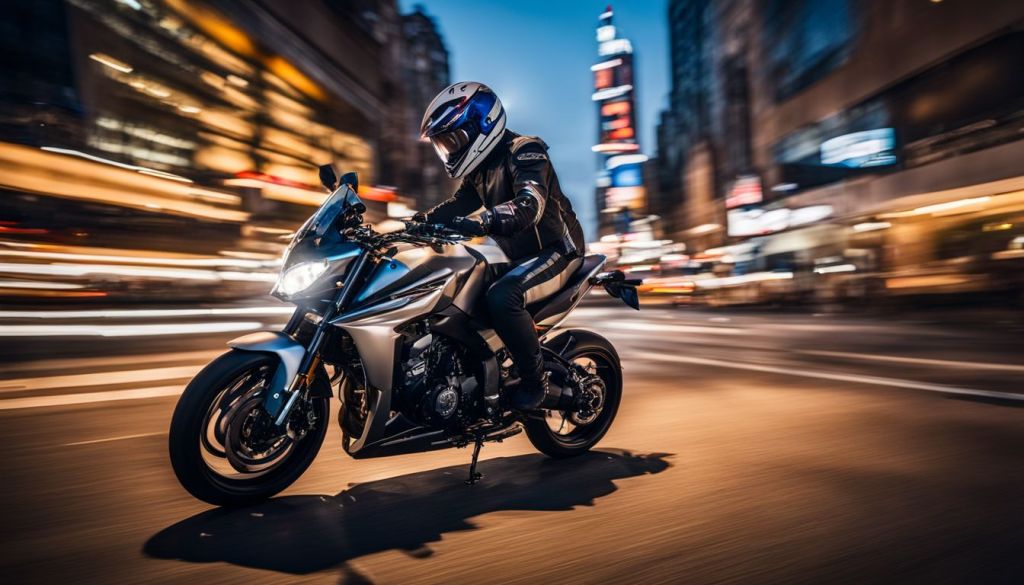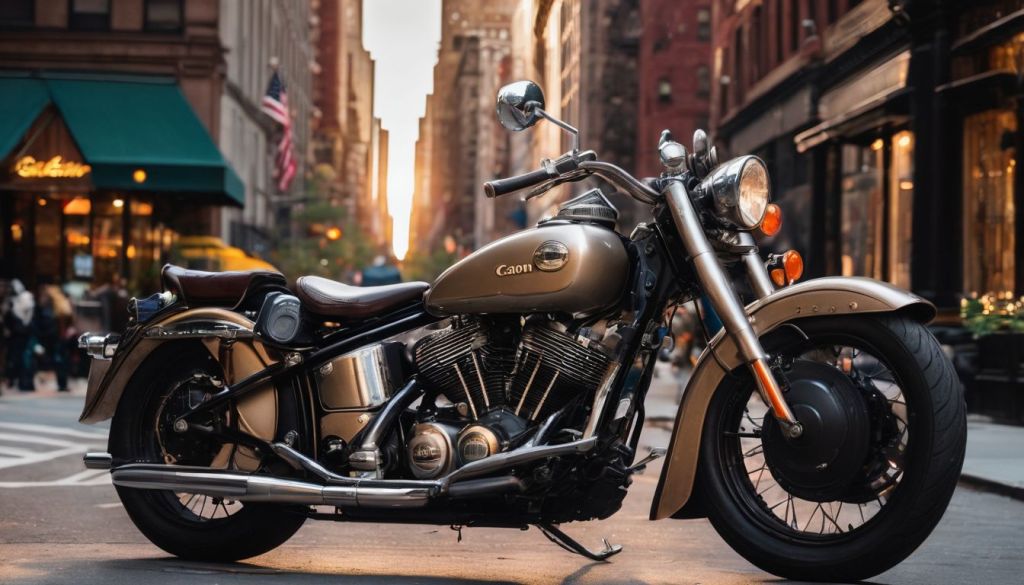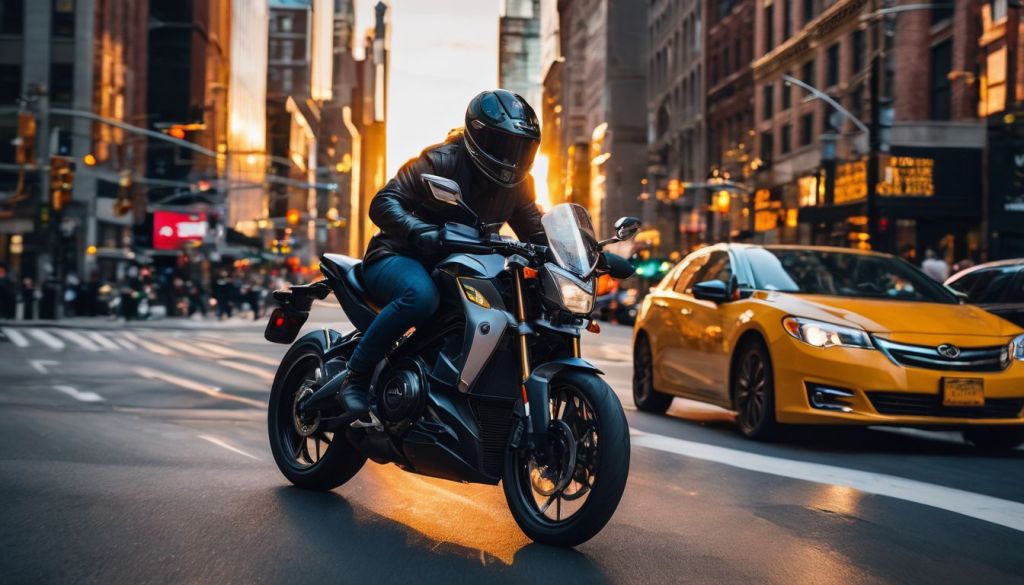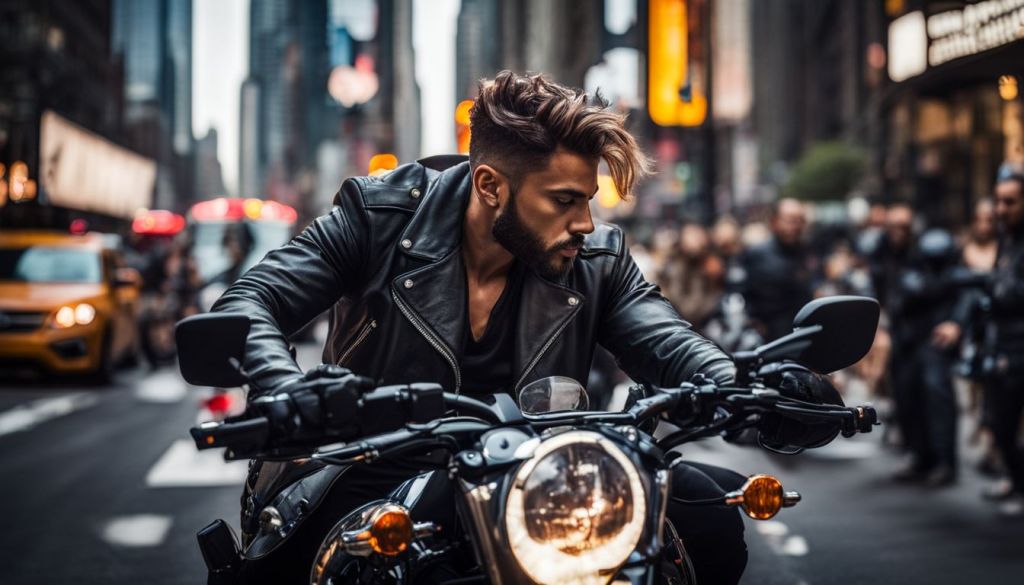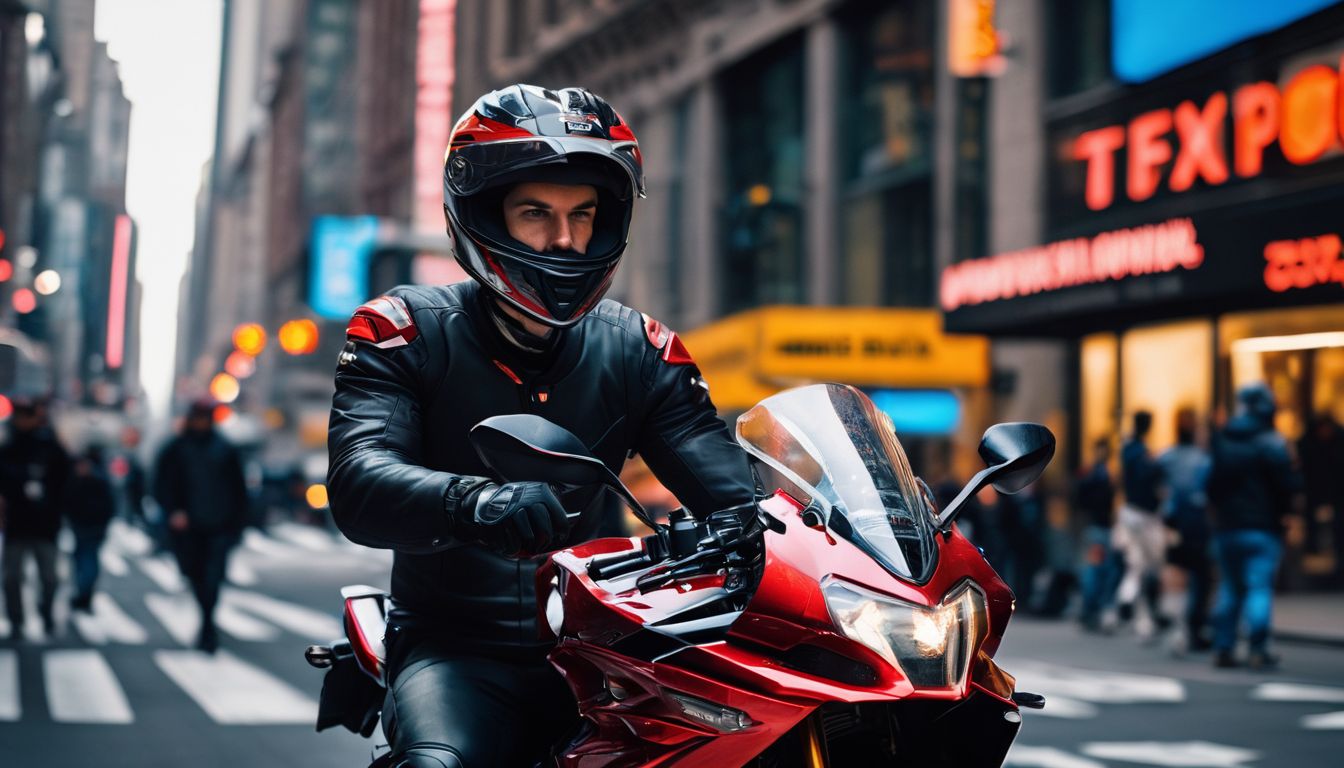
Riding a motorcycle in New York City is an experience unto itself – it’s the ultimate test of wits and reflexes. As someone who has spent years weaving through this urban tapestry on two wheels, I understand that mastering the delicate balance between swiftness and safety takes more than just knowing how to ride; it’s about becoming one with the ebbs and flows of city traffic.
The real art lies not only in following street signs but also in reading the unspoken language of this vibrant metropolis.
It’s sobering to consider that those of us on motorcycles are often more vulnerable amidst the hustle and bustle, with stark statistics like 141 fatalities a year serving as a somber reminder of our unique challenges.
These figures aren’t meant to intimidate but rather to underscore the importance of vigilance. This isn’t merely about personal safety – it’s about contributing responsibly to the shared pulse of New York City streets.
Navigating these roads calls for protective gear, yes, but also for wisdom gleaned from lived experiences and close calls that have shaped our savvy urban riding culture. So let’s zip up our jackets and adjust our mirrors – we’re not just riders; we’re guardians of each other’s journeys here in the heart-thumping canyons made not just from steel and stone, but from collective resilience too.
Ready? Let’s explore how you can be part of this dynamic symphony, maneuvering safely through Gotham’s grand grid.
Key Takeaways
- NYC riders must wear DOT-approved helmets and proper protective clothing such as long-sleeved jackets, pants, gloves, and over-the-ankle boots to stay safe amid city traffic.
- Motorcycle safety courses are recommended for all levels of riders to improve skills; they cover hands-on training, legal guidelines specific to New York City, risk management strategies, and tips for maintenance checks.
- Regular maintenance is crucial for motorcycle reliability in NYC: check tire pressure and tread depth frequently; inspect brakes properly; ensure lights function correctly; keep the chain or belt drive well-tensioned and lubricated.
- Staying alert, following traffic rules at all times, maintaining a visible presence on the road with reflective gear or additional lights, using hand signals along with turn indicators are key practices for avoiding accidents in busy urban environments like New York City.
- Utilize resources like the New York City Motorcycle Advisory Council for information on local regulations and safety initiatives. Stay updated with news from trustworthy sources including the Department of Motor Vehicles (DMV) and Governor’s Traffic Safety Committee.
The Importance of Motorcycle Safety in NYC
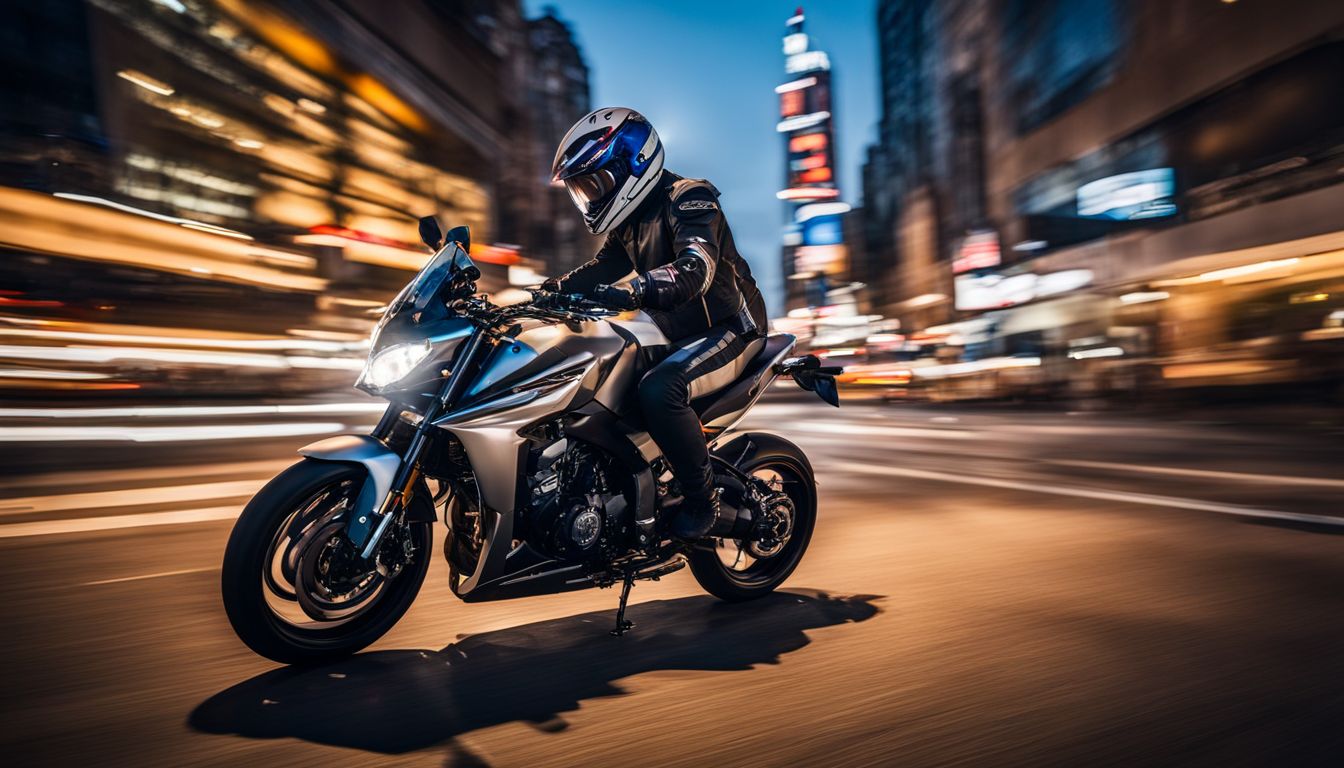
Motorcycle safety in New York City is essential due to the high volume of traffic and unique challenges presented by urban riding. To ensure a safe and enjoyable experience, it is important for riders to earn their New York motorcycle license, participate in safety courses, and stay updated on local motorcycle news.
Earn Your New York Motorcycle License
I know firsthand the thrill of weaving through New York City traffic, but with that excitement comes serious responsibility. Securing a New York motorcycle license is the first step in joining the vibrant community of NYC riders.
- Start with a study guide: Begin preparing for your motorcycle permit test by grabbing a New York State Motorcycle Operator’s Manual from the DMV or downloading it online.
- Ace the written exam: Ensure you’ve learned all about road signs, rules, and safety practices to pass the written knowledge test required to get your motorcycle learner’s permit.
- Grab your gear: Before taking any riding test, equip yourself with the mandated protective gear, including a DOT-approved helmet and proper clothing for safe riding in NYC.
- Practice on actual roads: Use your learner’s permit to gain real-world riding experience under the guidance of a licensed motorcyclist over 21 years old.
- Schedule your road test: Once you’re confident in your skills, book a road test appointment through the DMV to demonstrate your ability to safely handle a motorcycle in traffic.
- Cultivate safe habits: As you prepare for your test, remember that riding in New York requires using both arms and legs at all times – make these actions second nature.
- Complete mandatory courses: If under 18, you must take an approved driver education course or pre-licensing course before scheduling your road test for full license eligibility.
- Meet specific requirements: Ensure you understand all state regulations and standards including vision tests and other prerequisites before approaching the road test date.
- Consider additional training: For extra confidence and skill polishing, enroll in courses like those offered at Big Apple Motorcycle School which cater specifically to New York urban motorcycle safety.
- Embrace ongoing education: Even after earning my license, I never stop learning; I stay updated with online safety resources and courses to enhance my street smarts on NYC roads.
Basic RiderCourse – 3-Wheel
Navigating the streets of New York City on three wheels presents a unique set of challenges. I found that honing my skills through the Basic RiderCourse for 3-Wheel motorcycles offered me much-needed confidence.
- This course teaches you how to handle a three – wheeled motorcycle with ease, ensuring safe travel in busy urban environments.
- You’ll start with the basics of operation, including steering, braking, and turning, before progressing to more advanced techniques.
- The classroom component covers critical safety information and riding strategies specific to three-wheelers.
- On-the-range practice sessions give you hands-on experience under the watchful eye of certified instructors.
- Instructors provide personalized feedback to help you refine your riding abilities and adopt safe practices.
- Completing this course could qualify you for insurance discounts and waivers for certain DMV tests.
- Course materials emphasize understanding NYC motorcycle safety laws to keep you legal on the road.
- You’ll learn about pre – ride inspections, vital for spotting potential issues like loose bolts or worn tires before they cause problems.
- Discussions on protective gear stress the importance of proper helmets that meet New York State regulations—no novelty helmets allowed!
- The curriculum includes defensive riding techniques essential for avoiding accidents on NYC’s congested streets.
- Upon finishing, graduates grasp the complexities of urban traffic awareness needed for navigating New York City.
Become a Motorcycle Safety Foundation Certified RiderCoach
After mastering the three-wheel basics, you might feel ready to step up and share your skills. Becoming a Motorcycle Safety Foundation Certified RiderCoach empowers you to train new riders in New York City.
New York Motorcycle News
After obtaining the essential safety training as a certified RiderCoach, staying updated with New York Motorcycle News is crucial for NYC riders. Keeping abreast of local regulations, traffic updates, and safety initiatives can enhance rider awareness and preparedness for the unique challenges of riding in this bustling city.
New York City has specific laws and initiatives aimed at promoting motorcycle safety. Staying informed about new legislation, road closures, and safety campaigns empowers riders to adapt their practices accordingly and contribute to a safer environment for all road users.
Moreover, being aware of current trends in protective gear, technological advancements in motorcycle safety equipment, and community events fosters a culture of continuous learning and improvement among motorcyclists.
Must-Have Gear for NYC Motorcycle Riders

NYC motorcycle riders need to prioritize safety by investing in essential gear such as helmets, protective clothing, gloves, and boots. To learn more about the importance of these items and how they can keep you safe on the road, continue reading below.
Helmets
Wearing a helmet is crucial for protecting your head in case of an accident. In New York City, motorcycle riders are required by law to wear DOT-approved helmets to ensure their safety on the busy streets.
Statistics show that helmets have been effective in preventing severe head injuries and fatalities in motorcycle accidents. So, invest in a high-quality helmet that fits properly and meets safety standards to safeguard yourself while riding through the bustling city.
The Department of Transportation study revealed the increased risk faced by motorcyclists on NYC streets, emphasizing the importance of protective gear like helmets. Furthermore, wearing a helmet not only provides personal protection but also sets an example for other riders and contributes to creating a safer riding environment for everyone on New York City’s roads.
Protective Clothing
As a motorcyclist in New York City, it’s crucial to prioritize safety by wearing the necessary protective clothing. This includes a long-sleeve shirt or jacket, long pants, and over-the-ankle boots.
These items provide essential protection in case of an accident and are mandated by the New York DMV to ensure riders’ safety on the city’s streets. Given the elevated risk faced by motorcyclists in NYC, especially due to the complex traffic patterns and road conditions, wearing proper protective gear is non-negotiable for all riders.
Additionally, as statistics show approximately 141 fatalities from motorcycle-related accidents occurring in NYC each year, with most involving males aged 20-44; it becomes even more critical for every rider to comply with these regulations and standards.
Gloves
When it comes to protective gear for motorcycle riders, gloves are an essential piece of equipment. Quality gloves not only shield your hands from abrasions in the event of a fall but also provide crucial grip and control when operating the motorcycle.
They help protect against wind, debris, and weather conditions, ensuring that you maintain comfort and dexterity during your ride. Additionally, wearing gloves can offer added warmth during colder temperatures or protection from sunburn on hot days.
It’s important to choose gloves that fit well and are specifically designed for motorcycle riding to ensure maximum safety and functionality on the road.
Boots
After discussing the crucial role that gloves play in protecting motorcycle riders, it’s important to emphasize another essential piece of protective gear: boots. In New York City, where riding a motorcycle demands heightened awareness and skill due to the busy streets and traffic, wearing over-the-ankle boots is not just a recommendation but a legal requirement.
The need for proper footwear cannot be overstated as it provides stability and protects the rider’s feet and ankles in case of an accident or skid.
Motorcycle boots are designed with sturdy materials such as leather or reinforced fabric, offering impact protection for the ankles and shins. Additionally, they often feature non-slip soles to provide traction when stopping at lights or maneuvering through traffic.
With statistics showing approximately 141 fatalities from motorcycle-related accidents annually in New York City alone, investing in high-quality over-the-ankle boots can significantly reduce the risk of severe foot injuries in the event of a crash.
Safety Practices for NYC Motorcycle Riders
Stay alert and follow traffic rules at all times, be visible to other drivers by using reflective gear and maintaining a safe distance from vehicles, perform regular maintenance checks on your motorcycle, and consider taking a motorcycle safety course to enhance your skills and knowledge of riding in the city.
Stay Alert and Follow Traffic Rules
Riding a motorcycle in New York City demands full attention and adherence to traffic regulations. I always keep my eyes on the road, continuously scanning for potential hazards such as pedestrians stepping off the curb or vehicles making sudden lane changes.
By staying alert, I can anticipate and react to unexpected situations promptly, reducing the risk of accidents.
Following traffic rules is crucial for safe riding in NYC. This means obeying speed limits, yielding right-of-way when required, signaling turns appropriately, and respecting traffic signals and signs.
As a responsible rider, it’s vital to be mindful of other road users and make decisions that prioritize safety for everyone.
Be Visible to Other Drivers
Make yourself visible to other drivers by wearing bright or reflective clothing. Reflective vests, jackets, and helmets can significantly increase your visibility, especially during low-light conditions.
Install extra lights on your motorcycle for better visibility; consider adding auxiliary brake lights or LED strips to make it easier for other motorists to notice you from a distance.
Use hand signals along with your turn signals to communicate your intentions clearly. Always ride in a position where you are visible to other drivers – avoid blind spots and stay out of the center lane when riding alongside cars.
Perform Regular Maintenance Checks
To maintain your motorcycle in top condition, it’s essential to perform regular maintenance checks. This ensures that your bike is safe and reliable for every ride. Here are important maintenance checks to conduct:
- Check tire pressure and tread depth regularly to ensure proper grip on the road.
- Inspect brakes for wear and tear, including brake pads and discs, and keep them well-adjusted.
- Change the oil and filter at regular intervals according to the manufacturer’s recommendations.
- Examine the chain or belt drive for proper tension and lubrication.
- Test all lights, indicators, and horn to ensure they are functioning correctly for optimal visibility on the road.
- Inspect the suspension components for signs of wear or leakage and adjust as needed for a smooth ride.
- Verify that all nuts, bolts, and fasteners are securely tightened throughout the bike to prevent any issues while riding.
- Clean and lubricate control cables such as throttle, clutch, and brake cables to maintain smooth operation.
- Ensure that the battery is charged properly and terminals are clean to avoid starting issues.
Take a Motorcycle Safety Course
I highly recommend taking a motorcycle safety course to enhance your riding skills and knowledge. Here are essential aspects covered in these courses:
- Hands-on Training: Courses provide practical, hands-on experience to improve your maneuvering and control of the motorcycle in different road and weather conditions.
- Traffic Awareness: These courses emphasize the importance of being aware of other vehicles on the road, teaching defensive riding techniques to anticipate and avoid potential hazards.
- Risk Management: Participants learn how to assess risks and make informed decisions while riding, including strategies for handling emergency situations.
- Legal Guidelines: Courses educate riders on New York City’s specific traffic laws and regulations, ensuring they understand their rights as motorcyclists.
- Group Riding Skills: Many courses include group riding simulations to teach riders how to navigate safely within a pack of motorcycles, emphasizing communication and coordination among riders.
- Maintenance Essentials: Participants receive guidance on basic motorcycle maintenance checks and tips for keeping their bikes in optimal condition, promoting safe and efficient operation.
Resources for NYC Motorcycle Riders
Explore the New York City Motorcycle Advisory Council, Department of Motor Vehicles, Governor’s Traffic Safety Committee, Big Apple Motorcycle School, as well as online safety resources and courses for comprehensive support in motorcycle safety and education.
New York City Motorcycle Advisory Council
As a NYC motorcycle rider, joining the New York City Motorcycle Advisory Council can provide valuable resources and support. This council works to promote safety and awareness among motorcyclists in the city, offering access to information on local regulations, safety tips, and events.
By engaging with this advisory council, riders can stay informed about important updates regarding protective gear requirements and safety practices specific to riding in New York City.
The council also serves as a platform for sharing experiences and receiving guidance from experienced riders, contributing to increased safety awareness throughout the community.
Riders are encouraged to take advantage of the opportunities presented by the New York City Motorcycle Advisory Council as they seek to enhance their skills and prioritize road safety.
Department of Motor Vehicles
To ensure safety and compliance with regulations, all motorcycle riders in New York City must adhere to the guidelines set forth by the Department of Motor Vehicles. The DMV mandates that riders obtain a motorcycle license to legally operate their vehicles on city streets.
In addition, the DMV enforces regulations regarding the use of protective gear, including helmets and other apparel, to mitigate risks associated with riding in an urban environment like NYC.
Adhering to maintenance checks is essential for NYC motorcycle riders as it helps maintain optimal performance and ensures safe operation on the bustling city roads. Regular inspections are imperative for identifying potential issues such as worn tires or loose bolts, thus reducing the likelihood of accidents.
By following these guidelines provided by the Department of Motor Vehicles in New York City, riders can uphold safety standards while enjoying their motorcycling experience in this vibrant metropolitan area.
Governor’s Traffic Safety Committee
Transitioning from the Department of Motor Vehicles, it’s essential to look into the efforts made by the Governor’s Traffic Safety Committee in ensuring motorcycle safety in New York City.
The committee focuses on implementing laws and regulations to reduce accidents and fatalities on the city streets. By collaborating with law enforcement agencies and various organizations, the committee aims to address issues related to impaired driving, distracted driving, as well as improving overall traffic safety.
The Governor’s Traffic Safety Committee provides educational programs that specifically target motorcyclists, offering resources and information about safe riding practices, mandatory gear requirements, and how to navigate the unique challenges faced by riders in a bustling metropolis like New York City.
Big Apple Motorcycle School
The Governor’s Traffic Safety Committee provides valuable resources to enhance your motorcycling skills in New York City. Transitioning to the Big Apple Motorcycle School, riders can take advantage of professional training and guidance focused on enhancing safety practices and riding abilities.
With an emphasis on preventing accidents and prioritizing rider safety, this accredited school offers comprehensive courses that cover essential safety measures for navigating the streets of NYC.
The instructors at Big Apple Motorcycle School are dedicated to equipping riders with the necessary knowledge and techniques to confidently ride through the unique challenges presented by New York City’s bustling roads.
Online Safety Resources and Courses
As a New York City motorcycle rider, finding online safety resources and courses can greatly enhance your riding skills and knowledge. Here are some valuable resources to consider:
- Big Apple Motorcycle School: Offers online safety courses covering topics such as defensive riding techniques, road hazard awareness, and emergency maneuvers.
- Motorcycle Safety Foundation (MSF): Provides a range of online resources, including interactive modules, videos, and printable guides on various aspects of motorcycle safety.
- New York City Motorcycle Advisory Council website: Offers access to online forums, webinars, and downloadable safety manuals tailored to NYC riders.
- Department of Motor Vehicles (DMV) Online Safety Courses: Provides access to comprehensive online programs covering state-specific regulations, traffic laws, and accident prevention strategies for motorcyclists in New York City.
- Governor’s Traffic Safety Committee Webinars: Hosts live webinars featuring expert speakers who cover topics such as the latest safety gear technology, risk assessment strategies for urban riding, and understanding NYC traffic patterns.
- Online Safety Forums for NYC Riders: Joining online discussion groups dedicated to motorcycle safety in New York City can offer valuable insights into local riding conditions and tips from experienced riders.
- Interactive Virtual Riding Simulators: Several platforms offer virtual reality simulators that allow you to practice navigating NYC streets in a safe, controlled environment while honing your hazard recognition skills.
Conclusion
Enhancing motorcycle safety in NYC demands diligence and commitment. By prioritizing the right gear, from helmets to protective clothing, riders can mitigate potential risks. Incorporating safety practices like regular maintenance checks and staying visible on the roads is crucial for ensuring a safe ride through New York City’s bustling streets.
Remember, being proactive and informed about resources available is key to fostering a culture of safety among NYC motorcycle riders.
FAQs
1. What essential gear do NYC motorcyclists need for safety?
Protective gear for NYC motorcyclists is crucial. Riders should wear a motorcycle helmet approved by the Department of Transportation, along with appropriate motorcycle apparel like jackets, gloves, and boots to safeguard against injuries.
2. How can I learn safe riding practices in New York City?
Motorcyclist safety training in NYC offers courses on traffic awareness and defensive driving techniques specifically tailored for the city’s unique conditions. These courses teach vital skills for preventing accidents on NYC roads.
3. What are some motorcycle riding safety tips specific to NYC?
Essential safety checks before hitting the road include ensuring your bike’s lights, brakes, and signals work correctly. Always stay alert to New York City’s dynamic traffic patterns and practice lane positioning that increases visibility to other drivers.
4. Where can I find a New York City motorcycle safety course?
New York City provides various options for riders seeking motorcycle safety courses. You can enroll in programs that offer comprehensive guidance ranging from basic handling skills to advanced riding strategies designed to navigate the bustling streets safely.
